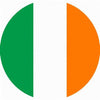How do I troubleshoot eyetracking calibration issues?
There are a few hurdles you may face when trying to get a successful or suitable calibration. Below are some situations and tips on what can be done.
If the user constantly receives poor calibration results try to:
- Ensure proper positioning - Open Gaze Interaction Settings and choose to open the Track Status window. In the multi-colored distance meter along the right side of the window, make sure the white triangle appears steady in the green area. If the arrow is correct in the distance meter, it typically helps to raise the device higher so that the user's eyes create a straight line to the middle of the screen.
- Ensure no environmental factors are causing issues. - From the point of view from the eye tracker, make sure there is nothing that may be reflective around or behind the user. Since the device uses infrared light, it is sometimes difficult to see if something is reflective in normal light. It may help to shine a small flashlight from the bottom of the device toward where the eye tracker is pointing. Please make sure not to shine the flashlight in the user's eyes. If the user wears glasses, try taking off the glasses and shine the flashlight on them to find if they give off any reflection.
If the user can only select items on one part of screen:
- Adjust calibration area to the side they are strongest on - The calibration results can tell you if the user has better access seeing one part of the screen. You can set up the calibration area to cover only the part of the screen that the user has the most success in order to get a better calibration. To do this:
- In Gaze Interaction Settings choose the Calibration section and select the Settings... button.
- Select the Change... button next to Calibration area.
- The screen with turn an opaque blue. Drag the sides of the opaque blue square to cover the section of the screen that the user is successful calibrating most.
- Select OK.
- Choose Apply.
- Try calibrating again. The calibration points should only cover the part of the screen you set to be the calibration area.
If some (but not all) of the calibration point results have lines that stretch far out of the small circle you may want to improve them.
- To improve a point, select that point in the calibration results and choose Improve Point(s).
The user may have difficulty following the calibration stimulus as it moves across the screen. If so, try these tips in the calibration settings screen:
- Adjust the size of the stimulus. Use the Stimulus size field to choose between Large, Medium, or Small.
- Create a deeper contrast – Change the colors in the Background color and Stimulus color fields.
- Change the stimulus type to an image or video that the user may be more attracted to. The Stimulus Type field can be changed to Dot, Image, or Video. If Image or Video is selected, a Primary Stimulus must be selected. A secondary stimulus is optional.
- Use the keyboard step-through to move the stimulus during the calibration when the user is ready. Next to Stimulus speed check Keyboard step-through. Instructions on how to use Keyboard step-through appear directly below the Keyboard step-through field.
If after calibrating, the calibration results from one eye is better than the results for the other eye, select "Track only this eye for Gaze Interaction" below the good calibration results.















